Summer fun: Camden, Panbots & Gizmo
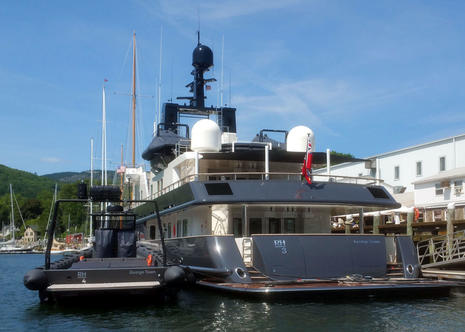 Have we reached the era when “special ops” makes sense as a superyacht style? I joke, but RH3 would be pretty imposing even if it weren’t cruising Maine in company with the all-black, dual jet drive, 40-foot-plus RH4. Given the two other substantial black tenders on the boat deck — and lord knows what’s in the hidden arms lockers (ok, I’m fantasizing, but armament is a seriously untold big yacht story) — this team seems ready to fend off a serious bad guy attack or invade a small island nation…
Have we reached the era when “special ops” makes sense as a superyacht style? I joke, but RH3 would be pretty imposing even if it weren’t cruising Maine in company with the all-black, dual jet drive, 40-foot-plus RH4. Given the two other substantial black tenders on the boat deck — and lord knows what’s in the hidden arms lockers (ok, I’m fantasizing, but armament is a seriously untold big yacht story) — this team seems ready to fend off a serious bad guy attack or invade a small island nation…
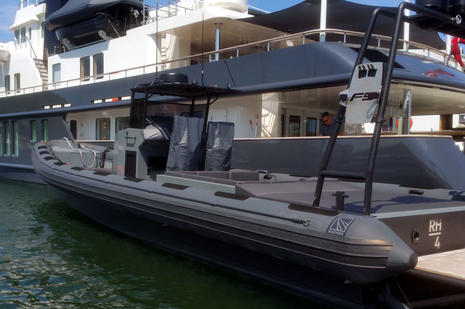 RH3 is even somewhat mysterious as an AIS target because it’s still listed at Marine Traffic under the prior name Private Lives. With that intel, we learn that this 120-foot expedition yacht (with a range of 5,000 nm at 10.5 kn) was sold in early 2014 and went to Florida for a “massive refit” and the distinctive restyling. Wouldn’t it be interesting to know about the new electronics that probably went onto the ship and tenders (and also about those unusual overhead light fixtures)? RH3 departed Lunenberg this morning, headed north, and was probably the talk of the harbor as here in Camden last week.
RH3 is even somewhat mysterious as an AIS target because it’s still listed at Marine Traffic under the prior name Private Lives. With that intel, we learn that this 120-foot expedition yacht (with a range of 5,000 nm at 10.5 kn) was sold in early 2014 and went to Florida for a “massive refit” and the distinctive restyling. Wouldn’t it be interesting to know about the new electronics that probably went onto the ship and tenders (and also about those unusual overhead light fixtures)? RH3 departed Lunenberg this morning, headed north, and was probably the talk of the harbor as here in Camden last week.
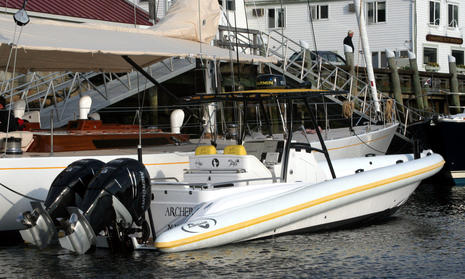 While it seems fairly common for high-end yachts to carefully paint away brand names, this customized Airship RIB 330 went the other way. Do you suppose that Garmin helps when someone wants to highlight their 18 xHD Radome so sharply? Judging from the name and logo this speed machine is associated with the handsome sailing catamaran Archer, which I haven’t seen yet but know to be an Outremer 51 recently test sailed by Sail’s Peter Nielsen. This is yacht watching season in Penobscot Bay and thanks to AIS, Marine Traffic, and Google for the help.
While it seems fairly common for high-end yachts to carefully paint away brand names, this customized Airship RIB 330 went the other way. Do you suppose that Garmin helps when someone wants to highlight their 18 xHD Radome so sharply? Judging from the name and logo this speed machine is associated with the handsome sailing catamaran Archer, which I haven’t seen yet but know to be an Outremer 51 recently test sailed by Sail’s Peter Nielsen. This is yacht watching season in Penobscot Bay and thanks to AIS, Marine Traffic, and Google for the help.
 Speaking of AIS, regular Panbo reader Don Joyce sent in this impressive screen showing the Nobeltec TimeZero charting software on his vintage 78-foot Cat’s Meow detailing a Class A target vessel almost 100 miles away. The atmospheric conditions were no doubt friendly, but Don has also smartly equipped his Raymarine AIS650 Class B transceiver with super low loss LMR-400 coax cable running 105 feet up the mast to a Shakespeare 6396-AIS Phase III antenna.
Speaking of AIS, regular Panbo reader Don Joyce sent in this impressive screen showing the Nobeltec TimeZero charting software on his vintage 78-foot Cat’s Meow detailing a Class A target vessel almost 100 miles away. The atmospheric conditions were no doubt friendly, but Don has also smartly equipped his Raymarine AIS650 Class B transceiver with super low loss LMR-400 coax cable running 105 feet up the mast to a Shakespeare 6396-AIS Phase III antenna.
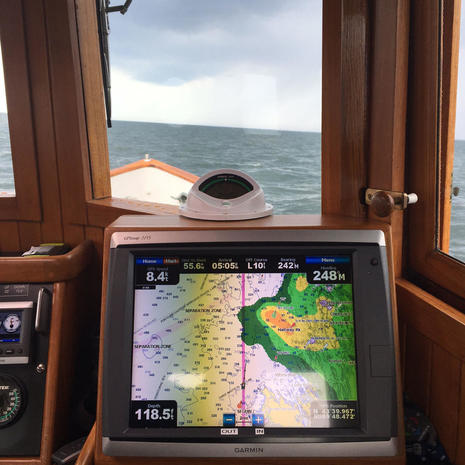 “Everything working well…” was the short email that came along with this pilot house image as the splendid Lord Nelson Victory Tug Sally W negotiated a thunderstorm while steaming from Camden to Portland (and points south). Panbot Allan Seymour has a GXM 51 XM satellite weather receiver networked to his GPSmap 7215 and hence real time NEXRAD rain density information helping him strategize the situation.
“Everything working well…” was the short email that came along with this pilot house image as the splendid Lord Nelson Victory Tug Sally W negotiated a thunderstorm while steaming from Camden to Portland (and points south). Panbot Allan Seymour has a GXM 51 XM satellite weather receiver networked to his GPSmap 7215 and hence real time NEXRAD rain density information helping him strategize the situation.
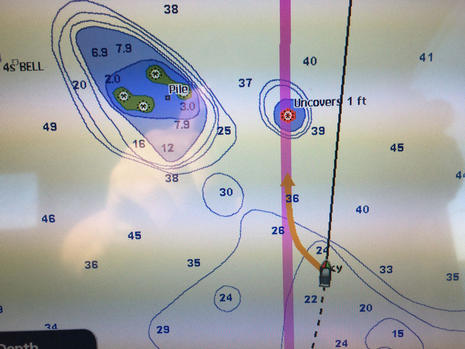 But a few days later, Allan sent this screen photo of Garmin Auto Guidance making a serious routing mistake somewhere near Hull, Massachusetts, adding, “7215 is set to Safe Depth 12.0. And NORMAL shoreline distance. And yet????” Well, I’ve yet to test a marine auto routing system that doesn’t sometimes make mistakes, so I’m glad that Allan is a careful navigator and hope everyone else is too. And testing the latest auto routing — like Raymarine’s implementation of Navionics Dock-to-dock and Garmin’s Auto Guidance 3.0 — is definitely on the Panbo agenda.
But a few days later, Allan sent this screen photo of Garmin Auto Guidance making a serious routing mistake somewhere near Hull, Massachusetts, adding, “7215 is set to Safe Depth 12.0. And NORMAL shoreline distance. And yet????” Well, I’ve yet to test a marine auto routing system that doesn’t sometimes make mistakes, so I’m glad that Allan is a careful navigator and hope everyone else is too. And testing the latest auto routing — like Raymarine’s implementation of Navionics Dock-to-dock and Garmin’s Auto Guidance 3.0 — is definitely on the Panbo agenda.
Admittedly, the testing agenda has been going slow, but one reason I’ve been hanging around the harbor so much (and sometimes vicariously enjoying other’s cruising) is a lot of install work. “Glass Bridge II” is almost complete, with the reinstalled Simrad NSS evo2 16 the only remaining MFD from the 2014 glass bridge set up. That’s a Garmin GPSmap 7612 in the ScanStrut Deck Pod and a Furuno TZT2 12 panel mounted alongside the NSS. Since I took this photo last week, I’ve added a Raymarine eS128 to the left side of the bridge and got a chance to try them all out on the bay.
Of course I’m going to write much more — where should I start? — but I’m already seeing lots of improvements in all brands and several truly fine new features. And I include the Simrad in that comment; it’s been updated and, besides, the three newer MFD models are arguably a response to the value/feature package NSS evo2 offered in 2014. The wonderfully ranting marine installer, Bill Bishop, may think that general purpose Android machines will supercede dedicated marine MFDs on many boats, but I’m not so sure (and what fun to argue about it).
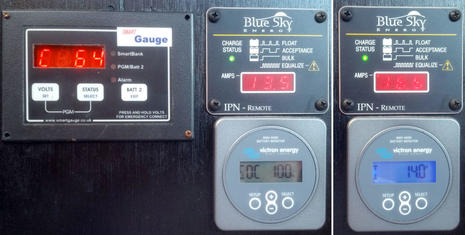 And, another wow, It’s been great to have the new Firefly Carbon Foam battery bank keeping Gizmo rich in 12-volt juice. In fact, the bank hasn’t been charged with shore power yet, even in the boatyard, and I’ve only run the engine once at the float after a long spell of poor solar power and much use of inverter, PCs, refrigeration, stereo, AIS, N2K networks, test MFDs, etc., etc. On the two short cruises we have made so far — tracked via inReach — I was delighted by how long the bank will take a high amperage charge when the State of Charge (SOC) has been run down by, say, showing off the new underwater lights.
And, another wow, It’s been great to have the new Firefly Carbon Foam battery bank keeping Gizmo rich in 12-volt juice. In fact, the bank hasn’t been charged with shore power yet, even in the boatyard, and I’ve only run the engine once at the float after a long spell of poor solar power and much use of inverter, PCs, refrigeration, stereo, AIS, N2K networks, test MFDs, etc., etc. On the two short cruises we have made so far — tracked via inReach — I was delighted by how long the bank will take a high amperage charge when the State of Charge (SOC) has been run down by, say, showing off the new underwater lights.
But I do have some tweaking to do on the battery monitoring systems (and maybe some additions). Blame neither the Smartgauge nor the Victron BMV-600S in the left-hand photo above, but the first is showing a 64% SOC, the other 100%, and neither is correct. For instance, on the right you can see that Gizmo’s solar panels are outputting 16.6 amps in bulk charge mode, 14 of which are going through the Victron shunt into the bank. That’s not what happens when the bank is truly at 100%. Counting amps is hard, however it’s done, and I may be able to improve both monitors with adjustments I haven’t attempted yet.
 But I did get a Furuno NXT solid state Doppler radar installed and this afternoon I hope to add the Raymarine Quantum. Will five radomes qualify as “special ops” style or do I need to apply a lot of black paint?
But I did get a Furuno NXT solid state Doppler radar installed and this afternoon I hope to add the Raymarine Quantum. Will five radomes qualify as “special ops” style or do I need to apply a lot of black paint?
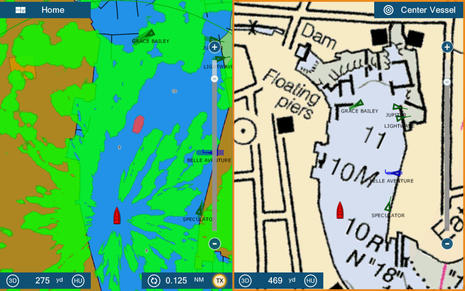 And, holy cow, within minutes of first installing the NXT it was automatically highlighting any vessel moving toward me in Camden Harbor, and that includes 10-foot tenders hidden behind a forest of masts. Wait until you see how well this radar performs underway, which has to be the next entry up.
And, holy cow, within minutes of first installing the NXT it was automatically highlighting any vessel moving toward me in Camden Harbor, and that includes 10-foot tenders hidden behind a forest of masts. Wait until you see how well this radar performs underway, which has to be the next entry up.
It will be harder to illustrate how well the Lumishore EOS mini and SMX92 LED underwater lights work, but I hope to have some fun trying.


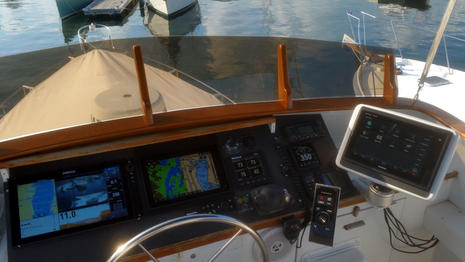
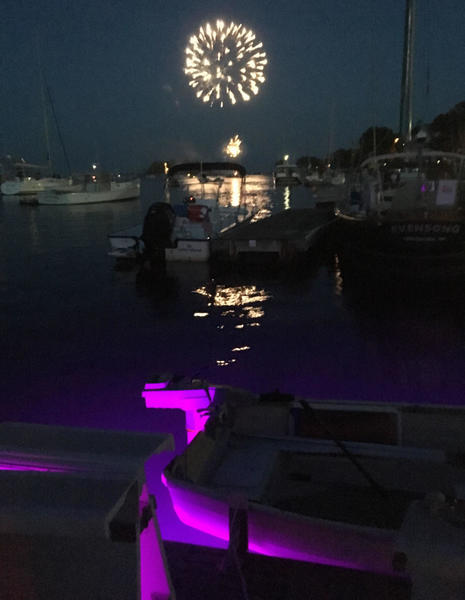
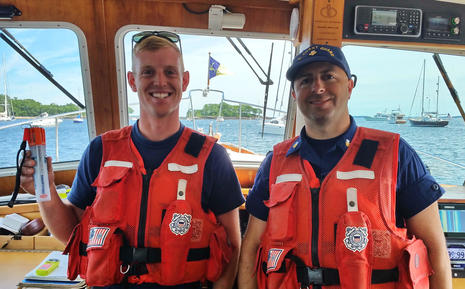

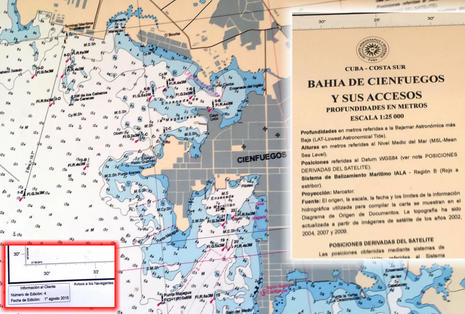
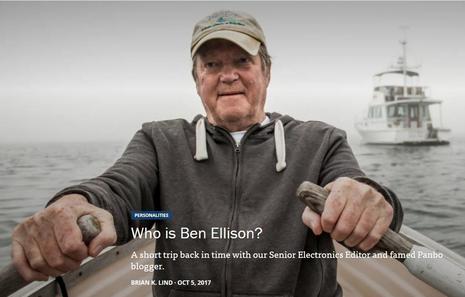







Incidentally, though it’s hard to see even if you click the photo of Gizmo larger, a bit of Camden Harbor brown slime has grown at the aft end of the port waterline. In fact it stops exactly where the “boosted” Pettit HydroCoat Eco test begins, which indicates that this bottom paint does benefit from added Zinc Omadine at least in this harbor.
Archer is the support tender for the sailing yacht being ratted up, Heroina. She also serves as a chase boat for the classic yacht Marilee, of the same ownership.
Thanks,
Dennis
Thanks, Dennis! I hope to watch some of the racing tomorrow and/or Saturday…
http://www.camdenclassicscup.com/
…and wish the boats great sailing.
Incidentally, I wrote about Marilee’s new interior design in March and hope that worked out well:
https://panbo.com/archives/2016/03/tbf_modeling_ny40_marilee_weems_plath_magnifier_young_mr_harding.html
Armed recreational boats? Say it isn’t so! Shades of the 17th century.. A pity so many states (and countries) want to throw you in jail for a .22 in a locker, let alone any actual armaments. But I guess the military appearance is pleasing to these folks – saw a big megayacht in Ft. Lauderdale that was painted Navy grey (though a LOT better paint job than any warship I ever saw up close) with a white number on the side. The actual name was in small black letters on the stern.
We’re creeping closer to ya, Ben – heading out of Handy’s in Falmouth Foreside on Sunday or Monday.. 🙂
Do those Navy painted vessels identify themselves as “warship” on the VHF? Interesting way to bluff a pirate approaching from a distance since presumably they would not want to get close enough to get a really good look.
I have had a few encounters with Navy ships in fog and haze and contacted them over VHF to negotiate passing. Usually easy to guess what is involved because of having a large radar target with no AIS data but they have never identified themselves. My favorite was the time I was out fishing and trolling around in heavy fog that had rolled in suddenly. I did a call on channel 16 to “vessel heading north” at their approximate location. I got an immediate response from a very professional sounding young man with no identification advising me that they had radar contact and I should maintain course and speed as they would pass close by my port side. The radar target got alarmingly large over the next several minutes until finally I saw a very big shape looming over me about 100 yards away, which I recognized as an Aegis equipped cruiser. At least then I was sure they knew exactly where I was within inches!
“Special ops” style yachts is a thing! Check out the Jarrett Bay 46 battle wagon Grander:
http://www.powerandmotoryacht.com/boats/jarrett-bay-46
I certainly wouldn’t think they would do that, since that would be a presumably fraudulent act. My guess is, they wouldn’t talk on the radio at all (which is what active warships would do).
All this “Spec Ops styling” is pretty funny – what *real* spec-ops does most of the time is try to blend in – the “grey man” approach – not draw attention with “militaristic” styling.. 🙂
Just noted a couple more things in this post, Ben – Don Joyce just missed us in his AIS picture – we left Baltimore that day, headed for the C&D canal. Not surprised he could see targets that far away, though – our AIS antenna is on the radar mount at about 30′ up, and we regularly see Class A targets at 50 miles.
What is this “harbor brown slime” thing you folks have here on the East coast? We never had a trace of a stain voyaging the entire West Coast (including Mexico) over the last year, and now we have a disgusting (and hard to remove!) stain all along the hull. I will admit that much of it probably came from Baltimore – a lovely place, but the filthiest harbor water I’ve ever seen.
Ben, thanks for your very interesting post.
The RHIB on two first pictures is a 13 meters Madera Rib, made in the Netherlands, it is the one of the best RHIB manufacturers in Europe, outside of Britain, and the tender can be seen on the Facebook page https://www.facebook.com/MaderaRibs/. They have many pictures of the boat there.
“This good-looking and very tough RIB that will be used as a tender for an luxury explorer yacht. The Rolls-Royce Kamewa Waterjets are powered by two 435 HP D6 Volvo Penta, which will give this M-RIB a max speed of 48 knots. The overall length including the diving platform is almost 15 meters and the beam is 4m”